MSI Z77 MPOWER Review: OC Certified LGA 1155 Mainboard from the Big Bang Series

This mainboard boasts a lot of advantages. Some are typical of all Micro-Star’s mainboards, some are unique for this particular model. However, it is also kind of tricky to work with and may require a good deal of patience on your part.
Micro-Star mainboards from the “Big Bang” series have one thing in common: the name. The boards within this series are totally different from one another, they were designed for different processors and platforms, had versatile features, but at the same time had nothing in common with the company’s regular mainstream products. They could boast such unique distinguishing features as the ability to support graphics cards from different makers or a large number of PCI Express slots, but when the MSI Z77 MPOWER mainboard joined this family, it seemed somewhat strange in the beginning. It seemed like a common mainboard that didn’t really stand out among others. It was also manufactured using high-quality “Military Class III” components, which reliability and stability were documented in an accompanying certificate, just like for other regular mainboards. The difference was that this mainboard underwent an additional test after all the quality controls have been successfully passed. This wasn’t just a common power-on test, but an intense 24-hour stress test of an overclocked system in the famous Prime95 utility, which generates heavy complex loads. This stress-test doesn’t just target the operation, but also confirms the board’s overclocking potential and allows marking it as “OC Certified”.

I have to say that the OC certification procedure is the primary and the most distinguished unique feature of the MSI Z77 MPOWER mainboard, but not the only one, of course. In our today’s review we are going to reveal new features and functions, which we have never seen before on Micro-Star’s mainboards, will uncover new BIOS settings and even new concerns. All this as well as performance, power consumption and much more will be discussed in this article.
Packaging and Accessories
Just like other Micro-Star mainboards from the Big Bang series, the front of the MSI Z77 MPOWER box is decorated with an image of a large explosion.
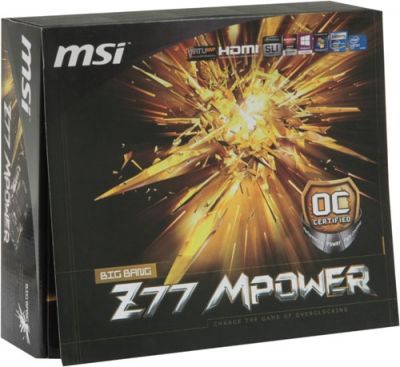
The front cover can be flipped open revealing a large photo of the mainboard and a list of its most important features.
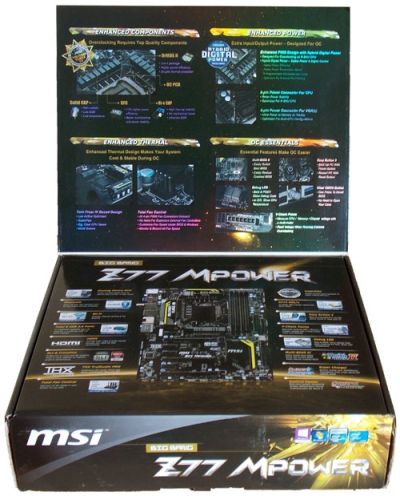
The description continues on the back of the box, where you can also find the photo of the mainboard’s back panel and the list of its official technical specifications.
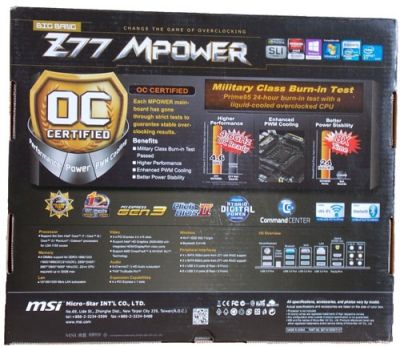
Besides the actual mainboard sealed in an anti-static bag, you will the following accessories:
- Four Serial ATA cables with metal connector locks, half with L-shaped locks and another half – with straight ones;
- A flexible bridge for 2-way Nvidia SLI graphics configurations;
- A Wi-Fi antenna;
- I/O Shield for the back panel;
- “M-Connector” block including modules for easy connection of the system case front panel buttons, indicators and audio;
- “V-Check Cable” adapter set for manual voltage monitoring with a voltmeter;
- User manual;
- A booklet on proprietary software;
- Illustrated overclocking guide;
- A booklet with brief assembly instructions;
- Reliability certificate listing all component testing methods;
- DVD disk with software and drivers.
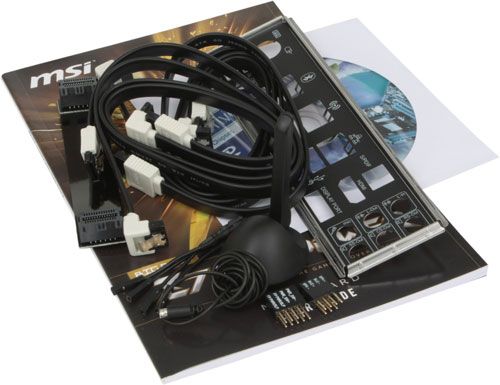
Design and Functionality
I have to say that the photo of MSI Z77 MPOWER doesn’t look too eye-catching: only the decorative stripes on the heatsinks brighten up the dark black and gray PCB. However, the board is very pleasant to handle: you can tell it’s a high-quality and thoroughly made product right from the start, although I have to say that the color-coding of the memory DIMMs, graphics card slots and SATA connectors could make its exterior a little more fun and make the assembly process a little easier.
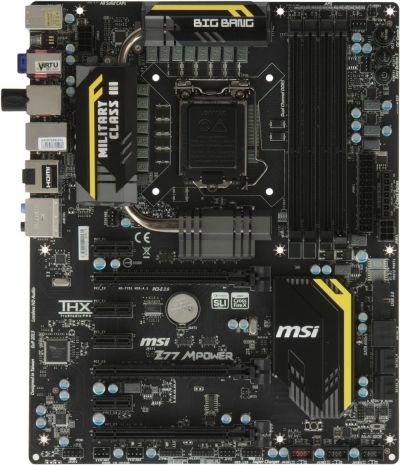
One of the typical peculiarities of Micro-Star’s mainboards is the use of high-quality “Military Class III” components, which reliability and stability are guaranteed by the accompanying certificate. The heating components of the digital processor voltage regulator circuitry and topped with two heatsinks of sophisticated shape. A thick 8 mm heat-pipe, instead of 6 mm heat-pipes used by other mainboard makers, connects these heatsinks to the central one, which doesn’t cover any special components, but simply provides additional heat-dissipating surface and indicates the board’s high-end status. All heatsinks including the fourth one on the chipset are securely fastened with screws.
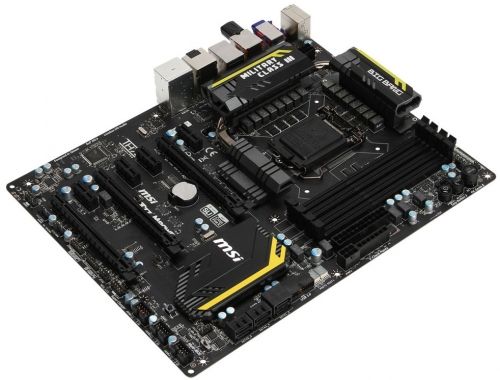
The mainboard can take one discrete graphics accelerator working at full PCI Express 3.0/2.0 x16 speed, or two working at x8 speed. If you are using an Ivy Bridge processor, you will have a third slot at your disposal, but the slot operational speeds will change to x8/x4/x4, according to the functionality of the Intel Z77 Express chipset used in this board. You can build ATI CrossFire or Nvidia SLI graphics configurations. Besides that, there are four more PCI Express 2.0 x1 slots for expansion cards. The chipset also provides the board with two SATA 6 Gbps ports and four SATA 3 Gbps ports. There are no additional SATA controllers onboard.
The mainboard’s back panel offers the following ports and connectors:
- PS/2 connector for keyboard or mouse;
- Two USB 2.0 ports, six more USB ports are available as three onboard pin-connectors;
- Clear CMOS button;
- Two USB 3.0 ports (blue connectors) implemented via Intel Z77 Express chipset, Another four ports are implemented via Renesas µPD720201 controller, and there is also an onboard pin-connector for two more USB 3.0 ports;
- Bluetooth 3.0+HS and Wi-Fi IEEE 802.11 b/g/n wireless modules;
- A local network port (network adapter is built on Gigabit Realtek RTL8111E controller);
- HDMI and DisplayPort Video outs;
- Optical S/PDIF, and six analogue audio-jacks provided by eight-channel Realtek ALC898 codec.

Here I would like to draw your attention to several things. Firstly, it is for the first time in our experience that a Micro-Star mainboard comes with integrated wireless technologies onboard. There could have been other mainboards, but we didn’t have a chance to test them, except for some really old MSI mainboards that came bundled with a separate Bluetooth module. Secondly, the USB 3.0 ports implemented in the chipset are accompanied by a Renesas controller. Only the very first mainboards with USB 3.0 support came with Renesas (NEC) controllers, but they have been almost completely replaced with the other manufacturers’ controllers by now. So, why are these chips still used on MSI mainboards? The thing is that Renesas µPD720201 is a new four-port controllers, which belongs to the third generation of USB 3.0 controllers from Renesas. These new chips are more compact, more energy-efficient and even faster than their predecessors. These were all the indisputable advantages of the back panel layout. The only drawback is the absence of the eSATA ports.
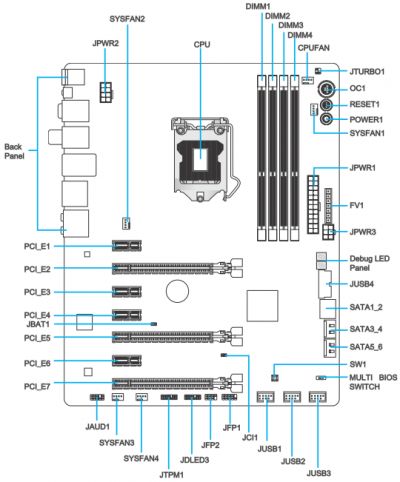
I would like to point out a number of other mainboard peculiarities. The graphics card slots have very convenient wide latches. The CPU Phase LEDs indicate the number of active phases in the processor voltage regulator circuitry, which changes dynamically depending on the operational load. Besides the Power On, Reset and Clear CMOS buttons, there is also an OC Genie button, which allows automatically overclocking the system. Another useful new feature is the GO2BIOS button, which will let you enter the BIOS upon the next boot-up without any additional effort on your part. There is a special switch that will allow you to set one of the two independent BIOS chips as primary. The POST code indicator will help identify boot-up problems. You can use V-Check Points and enclosed V-Check Cables to manually measure all important voltages. A six-pin additional power supply connector for multi-card graphics configurations is a questionable advantage, because the existing power supply connectors won’t be free and you will have to use some kind of adapters for that. There are five four-pin fan connectors. Four system fan connectors allow lowering the fan rotation speed even if you are using three-pin fans, but it will not work with a CPU fan.
The table below sums up all the major technical specifications of the MSI Z77 MPOWER mainboard:
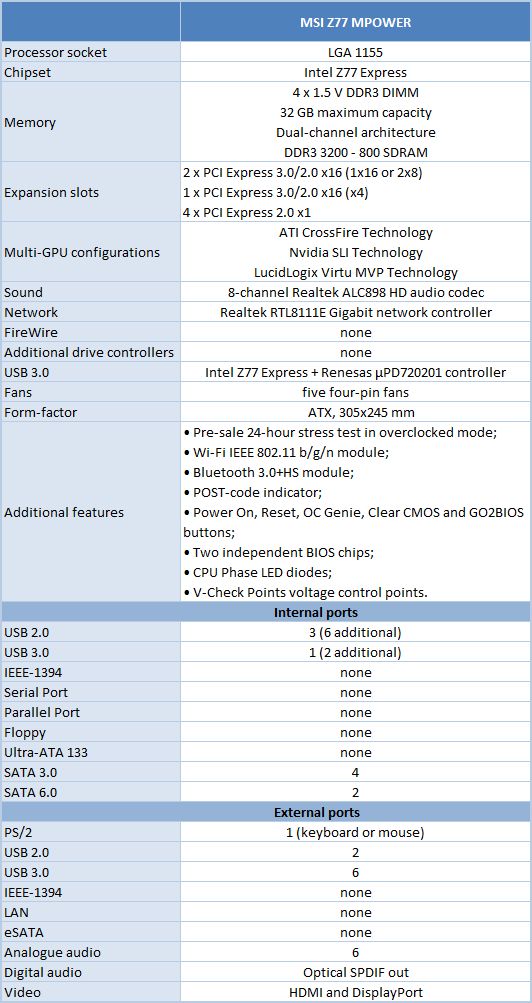
BIOS Functionality
In our previous MSI mainboard reviews we have already discussed MSI Click BIOS II, which represents a pretty successful implementation of the UEFI (Unified Extensible Firmware Interface) standard. The top of the screen performs not only informational functions but also allows choosing interface language, changing the order of boot-up devices by simply dragging and dropping them with a mouse pointer. The currently active devices will be highlighted.
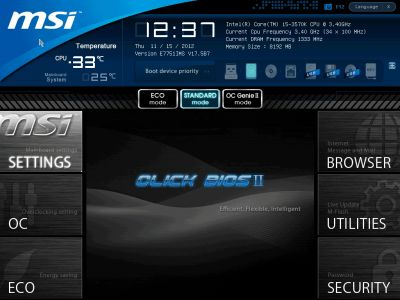
The center of the screen is allocated for displaying the BIOS settings, with main section icons on the -left and right-hand sides. Let’s get to the first section called “Settings”, which also contains a few sub-sections.
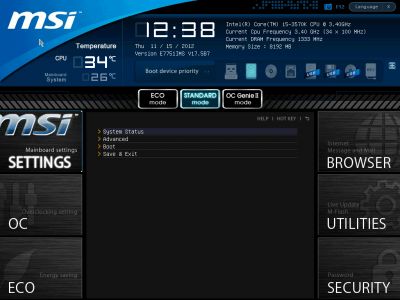
“System Status” sub-section is, in fact, the same startup screen, which we saw when we entered the regular traditional BIOS. It reports the major system info.
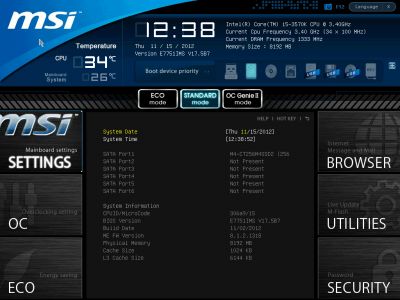
The variety of settings in the “Advanced” section is of no surprise to us, as they have migrated from the regular BIOS almost without any modifications. Here you can also enable and configure the unique technologies of the Intel chipset, such as “Intel Rapid Start” and “Intel Smart Connect”.
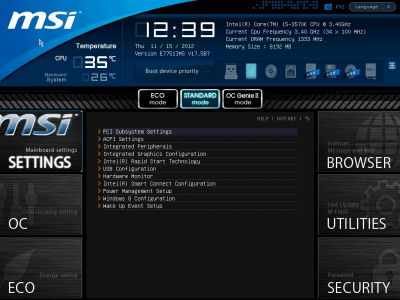
There is a new sub-section called “Windows 8 Configuration”, where you can enable the specific boot-up system typical of this particular OS and speed up the overall start-up time.
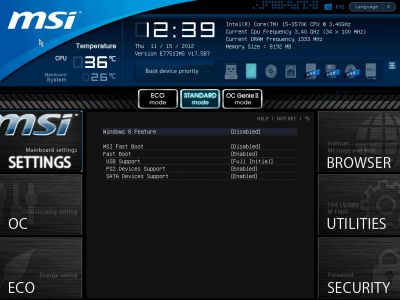
Now let’s check out the “Hardware Monitor” section where you can enable automatic adjustment of the CPU fan rotation speed depending on the current processor temperature. The adjustment works only for four-pin fans. All three-pin fans will rotate at their full speed. However, if you connect a three-pin fan to one of the four four-pin system fan connectors, its rotation speed will be lowered as needed. The rotation speed adjustment for these two fan connectors may be left at Auto or set at a specific level.
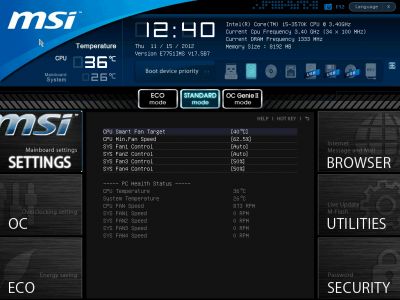
“Boot” sub-section will allow you to set the boot-up devices order and a number of other things used during system startup.
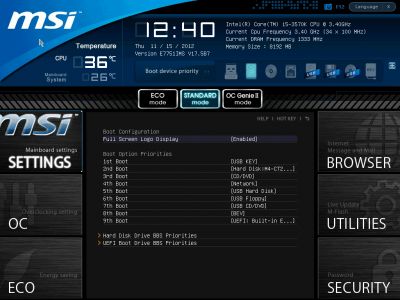
The functionality of the “Save & Exit” sub-section is obvious and doesn’t need an explanation.
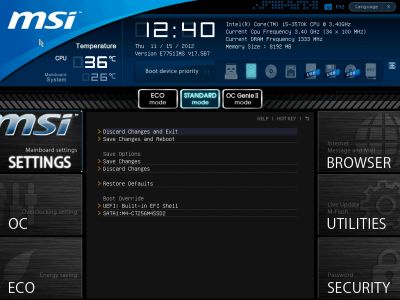
“OC” section is one of the largest in terms of available settings. It contains almost all options necessary for successful configuring and overclocking. It also has a number of informational parameters that report the current system status.
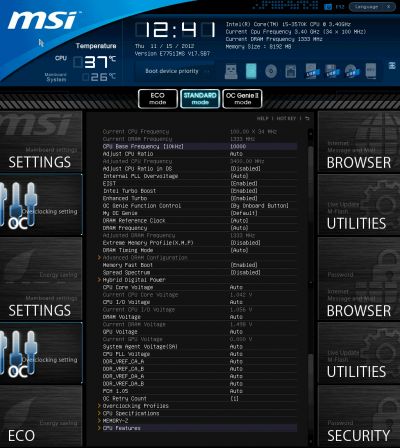
You can use “Enhanced Turbo” BIOS parameter if you want to slightly overclock the processor and at the same time keep all processor power-saving technologies up and running. When this function is on, under any type of load the processor clock frequency multiplier will rise to the maximum for this specific processor model as allowed by Intel Turbo Boost. If you want to achieve even higher results, you should use OC Genie II function that allows overclocking the system by selecting a proper option in the mainboard BIOS or by pressing the OC Genie button. Any automatic overclocking technology has a number of shortcomings, which could be partially smoothed out during user fine-tuning. “My OC Genie” parameter allows setting some of the parameters to desired values, which will be used during overclocking with the “OC Genie II” function.
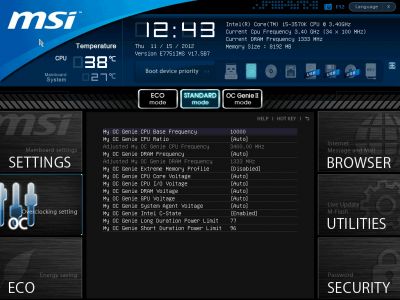
In order to make it easier to work in this feature-rich section, some parameters have been moved to individual pages. Namely, the memory timings have all been isolated in an individual sub-section. They may be identical for all memory channels, or set individually for each of them.
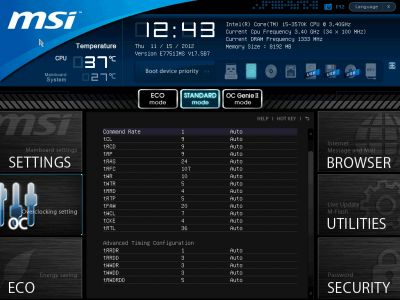
From now on all parameters related to the processor voltage regulator configuration have been moved onto a separate page called “Hybrid Digital Power”.
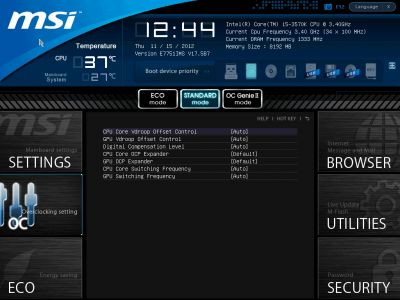
The mainboard can save six full BIOS settings profiles in the “Overclocking Profiles” sub-section. It allows saving and loading settings profiles from external media. One minor inconvenience is that you can’t tell which profiles have been used by looking at the list.
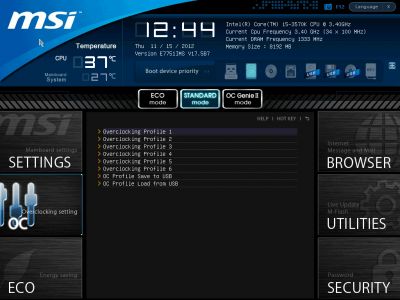
However, the actual work with the profiles is absolutely problem-free. The date and time of the profile creation as well as the BIOS version it belongs to are saved automatically for each profile. You can assign each profile a memorable descriptive name, or erase a profile from memory if necessary.
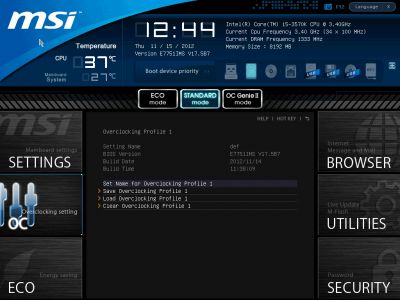
The next two sub-sections called “CPU Specifications” and “Memory-Z” perform purely informational functions. The first one tells us all the basic info about our CPU:
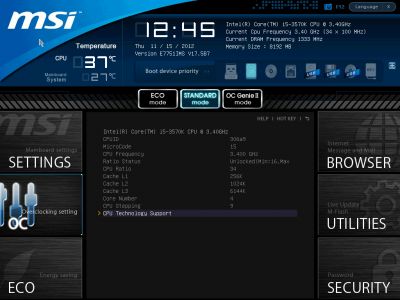
You can dig deeper, if you like, and check out the list of supported processor technologies.
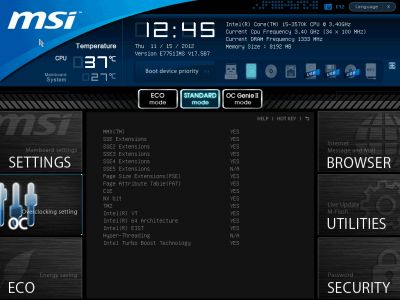
The “Memory-Z” sub-section is organized in a similar manner. The first thing you see is the information recorded in the memory modules SPD. The mainboard will use these particular settings by default.
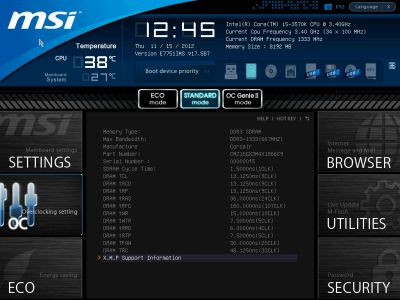
However, the actual potential of the memory modules can only be found in the “X.M.P.” profile, which you can also access through here.
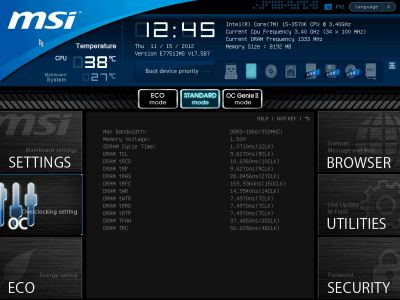
In the “CPU Features” sub-section we can configure processor clock frequency multipliers, acceptable power consumption range and various processor technologies. This very important sub-section for some reason was the last in the list, but it is still very easy to access it, because all parameters in the “OC” section are looped. You don’t have to keep pressing the “down” key endless number of times to get the last sub-sections or settings. Just press the “up” key once and you will get there immediately.
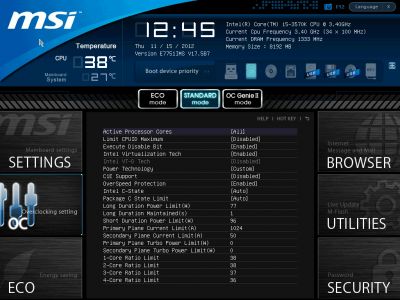
“ECO” section is what used to be “Green Power” before. Here we can work with some power-saving parameters, disable the onboard LEDs and control the current values of the most important voltages in the system.
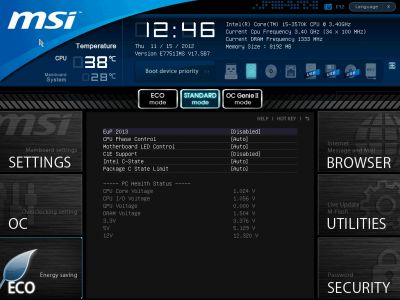
“Browser” icon on the right-hand side will let you browse the Internet, check your e-mail, use some office or IM apps, but only if you have previously installed Winki 3 Linux-based operating system from the included DVD disk.
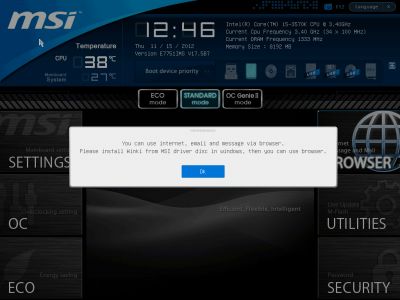
The same is true for HDD Backup and Live Update utilities, which are hidden behind the “Utilities” icon.
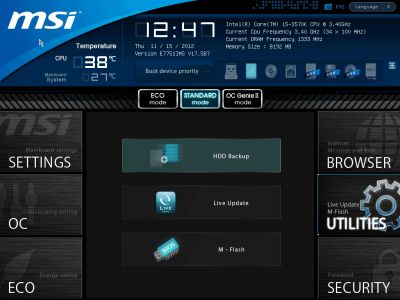
In the “M-Flash” sub-section we can try and boot using a BIOS image on a flash-drive, can save the current BIOS version or update it. It is somewhat inconvenient that the images are not only saved in the drive root folder, they should also be there for a successful update. There is no file manager of any sort, the NTFS file system is not supported, and the flash drive must be formatted as FAT or FAT32.
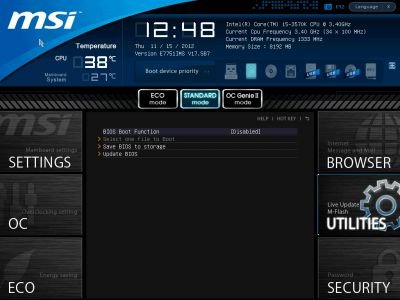
In the “Security” section you will be able to set passwords for system access, which is what other boards also allow. There is an interesting MSI’s own proprietary feature that will let you turn a common flash drive into an access key.
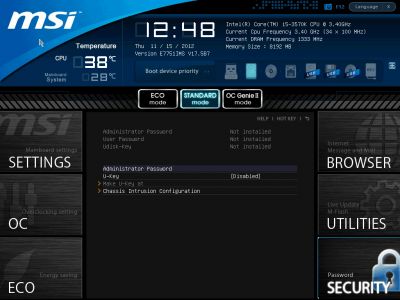
You can press F1 key at any time and while in any section of the BIOS to display the help topics. They also introduced new hot keys – F8 and F9, which allow you to load the settings profiles onto external storage media and load the profiles from them. I wish they have also made a key that could let you clear all the changes and go back to the previous settings in just one key stroke.
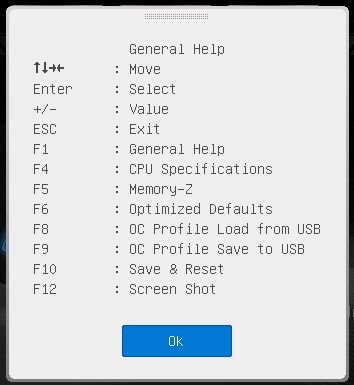
Overall, MSI Click BIOS II looks very easy to work with and illustrative, and the company improves it continuously. They introduce more new parameters that make working with this board even easier than it already is. However, they still haven’t gotten rid of the typical shortcoming all MSI mainboards possess: MSI mainboards are still unable to increase the processor core voltage in the “Offset” mode by simply adding the necessary value to the nominal. Moreover, most difficulties the users may experience with Micro-Star mainboards, usually originate from the BIOS issues, which we are going to discuss later in this review.
Testbed Configuration
We performed all our tests on a testbed built with the following components:
- Mainboard: MSI Z77 MPOWER, MS-7751 ver.4.1 (LGA 1155, Intel Z77 Express, BIOS version 17.5B7);
- Intel Core i5-3570K CPU (3.6-3.8 GHz, 4 cores, Ivy Bridge rev.E1, 22nm, 77 W, 1.05 V, LGA 1155);
- 2 x 4 GB DDR3 SDRAM Corsair Vengeance CMZ16GX3M4X1866C9R (1866 MHz, 9-10-9-27 timings, 1.5 V voltage);
- Gigabyte GV-T797OC-3GD (AMD Radeon HD 7970, Tahiti, 28 nm, 1000/5500 MHz, 384-bit GDDR5 3072 MB);
- Crucial m4 SSD (CT256M4SSD2, 256 GB, SATA 6 Gbps);
- Scythe Mugen 3 Revision B (SCMG-3100) CPU cooler;
- ARCTIC MX-2 thermal interface;
- Enermax NAXN ENM850EWT PSU;
- Open testbed built using Antec Skeleton system case.
We used Microsoft Windows 7 Ultimate SP1 64 bit (Microsoft Windows, Version 6.1, Build 7601: Service Pack 1) operating system, Intel Chipset Software Installation Utility version 9.3.0.1020, AMD Catalyst graphics card driver version 12.4.
Reflashing and Restoring the BIOS
All recently reviewed mainboards features convenient and thought-through design that is why it was very easy to assemble test systems based on them. MSI Z77 MPOWER mainboard was also no exception: we assembled the system very quickly and it was fully operational right from the start. However, shortly after we had to deal with a variety of challenges. First of all, upon the very first attempt to reflash the BIOS, one of the BIOS chips failed. Here I have to point out that the BIOS reflashing procedure with the M-Flash utility has been slightly modified. Previously, there was a single parameter that offered you to select a BIOS file. Now there is a second parameter that allows simultaneously updating the BIOS and the ME (Intel Management Engine). We selected the second option, because the list of changes introduced in the new BIOS version 17.4, which we were going to relfash, included “Update ME firmware”. Everything took off to a good start. We got a warning about the importance of uninterrupted reflashing process, and a continuous progress report in percents.
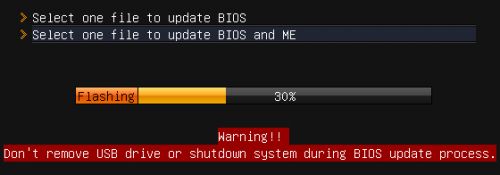
However, as soon as we got 50% through the process, another message popped up reminding us not to remove the drive with the BIOS file, because Intel ME will be updated immediately after system reboot.
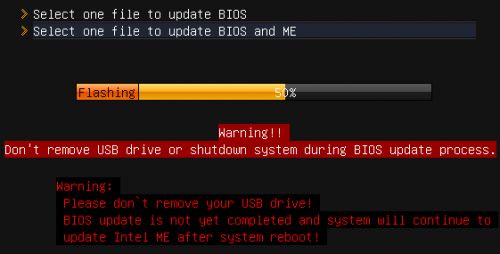
After system restart, the process continues and in the end we get a success confirmation.

I have to mention that we have already come across a similar two-step reflashing process on the mainboards from other manufacturers, for examples, Asus. However, there are a few very important differences between them. First, the user doesn’t have to decide between two mutually exclusive options – update just the BIOS or update the BIOS and the ME. There is only one option – update the BIOS. In this case the BIOS update proceeds normally, and if the file also contains the Intel ME update, it will automatically be performed right after the system reboot. The second important difference is that upon successful completion of step one, you may remove the USB drive, because the BIOS update file is saved in the memory and the process continues without interruption. However, you may easily overlook the second warming on MSI mainboard at a 50% mark. The only way to notice it is if you are constantly watching the status bar. I can easily picture a situation when the user walks away from the system for a minute and then comes back when it is already rebooting. He or she may assume that the reflashing has been successfully completed and may remove the USB drive, which will cause a failure and leave the user with a non-operational system. In our opinion, the new BIOS updating process on Micro-Star mainboards is somewhat confusing and poses higher risk of human error.
However, one non-operational BIOS chip is not the end of the world, because we have a backup chip, which can help restore the primary one. The description of the BIOS restore process is very simple and intuitive. Use the onboard switch to select the operational BIOS chip, boot the system, and if necessary save the operational BIOS image on a USB flash drive. After that switch back to the non-operational chip and restore it.
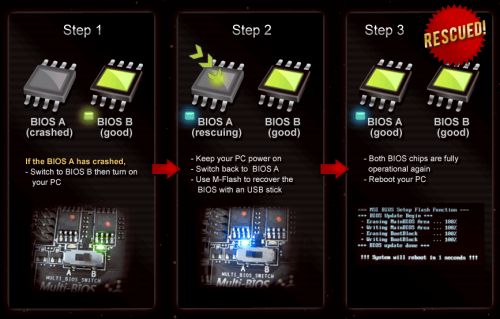
Everything is very simple, but unfortunately, it didn’t work. If we selected the “Update BIOS” option, the process completed, but the board still couldn’t boot. If we selected “Update BIOS and ME” parameter, the first step completed successfully, but after the system reboot the board still couldn’t start to complete the second step. Looks like the MSI’s BIOS restore procedure has failed again. Previously, we had issues with two BIOS chips on the MSI X79A-GD (8D), as you may remember from our review.
However, we didn’t lose hope. We still had an operational backup BIOS chip, which we could use. And we were right not to give up: the latest BIOS version available to us at the time of the review, version 17.4, had been successfully reflashed, and we proceeded to studying the mainboard functionality. However, we were struck with another series of challenges. First, we once again had some difficulties saving BIOS settings in the profiles with even numbers, although this time the problems were of a slightly different sort than before. As you may remember, when we reviewed MSI Big Bang XPower II and MSI X79A-GD65 (8D) mainboards, we were puzzled to notice that the settings saved in the even profiles simply disappeared after system reboot. This time, the profiles were there, but the system would freeze dead upon an attempt to restore the settings profile number 2, and in case of a profile number 4, the settings recovered were totally different from what we had previously saved in it.

Semi-operational settings profile system is a concern, but not a deal-breaker for studying the mainboard functionality. Unfortunately, we soon uncovered a more serious problem: the very first graphics card slot didn’t work properly. The card installed into it would work, but would show much lower performance, which sometimes would get as low as only half of the normal level. The second slot work fine, but it was design for a second graphics card, which meant that it only had half the pins. As a result, a single card installed into the second slot could only work at PCI Express 3.0 x8 speed, which would make a direct comparison against other mainboard unfair. As a result, we had to report the issues to MSI and wait until we could find a cure.
Thanks to very rapid and proactive response from MSI team, we soon managed to restore the non-operational BIOS chip with the help of Intel Flash Programming Tool. We even reflashed a beta BIOS version 17.5B7. Although the recovery process was a little tricky (we had to save the unique ID of our network card before the procedure), it wasn’t difficult at all.
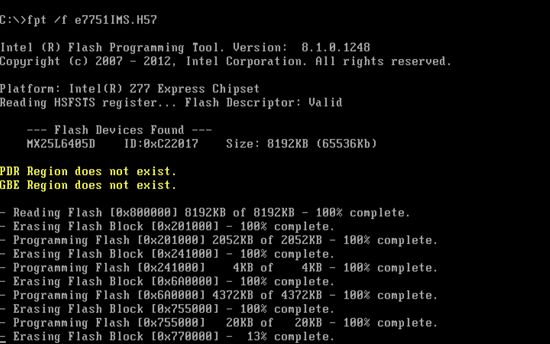
It turned out that the new beta BIOS didn’t have any of the issues related to settings profiles and the first graphics card slot was working perfectly fine again. We confirmed that there was no physical issue with the card slot by switching back to the backup BIOS chip with the version 17.4, when we would again witness lower graphics performance. Now with the new perfectly debugged BIOS we could finally proceed with our examination of the mainboard functionality and performance.
Operational and Overclocking Specifics
Upon boot-up MSI Z77 MPOWER mainboard displays a startup image where they remind us of the supported hot keys.
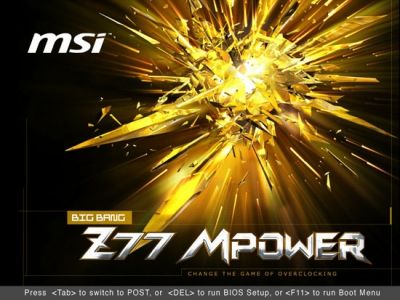
Moreover, even if you disable the start-up image in the settings or by pressing the Tab key, there will still be a hot key hint at the bottom of the screen. However, for some reason the mainboard no longer displays the current processor frequency. We only see the nominal frequency, which has nothing to do with the real one. We also see the system memory size and operational frequency there.
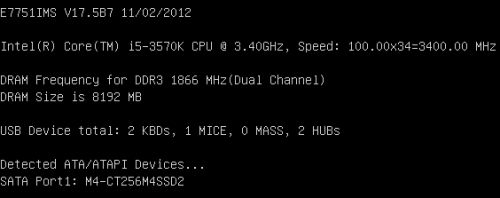
In our MSI Z77A-GD65 mainboard review, we were very pleased to see a new parameter in the BIOS called “Enhanced Turbo”. This parameter allows the processor clock frequency multiplier to rise to the maximum for this specific processor model as allowed by Intel Turbo Boost under any type of load. This is a very easy and safe way of slightly overclocking your system. However, today our opinion about this feature has changed, and we are inclined to consider its implementation on MSI Z77 MPOWER mainboard a drawback rather than an advantage. The first reason for that is the fact that “Enhanced Turbo” option is enabled by default, and therefore the processor is not working in its nominal mode. This function can be easily disabled, but even after that the nominal operational mode cannot be restored. Now the clock frequency multiplier of our test Core i5-3570X processor will rise only to 36x, although under low loads it should be able to rise to 38x. The thing is that the “Intel C-State” parameter is set at “Auto” in the BIOS, but in this case it doesn’t work, and you must manually change its setting to “Enabled”. Because of all that the MSI’s proprietary power-saving technology called APS (Active Phase Switching) also doesn’t work by default. Micro-Star has every right to consider this technology one of their mainboards’ advantages, and what happens when the advantage disappears? It would be wrong to assume that in this case nothing happens and that the board simply has one advantage less. When the plus is gone, the minus remains, and we are going to prove it during our power consumption tests later in this review.
Another peculiarity of Micro-Star’s mainboards is their automatic overclocking system called “OC Genie II”, which allows overclocking the system by selecting the corresponding option in the BIOS or by pressing the namesake button. We do not intend to overestimate its potential, because like any other automatic overclocking system it does have its imperfections, but it has a few undeniable positives. The thing is that many similar technologies from other manufacturers overclock only the processor, and totally leave out the memory. In our tests, we increased the processor frequency to 4.2 GHz, but the “OC Genie II” technology also increased the memory frequency to 1867 MHz and set all appropriate timings for it, with the help of the X.M.P. profile recorded in the modules SPD. This is the right approach, because system should be overclocked in its entirety.
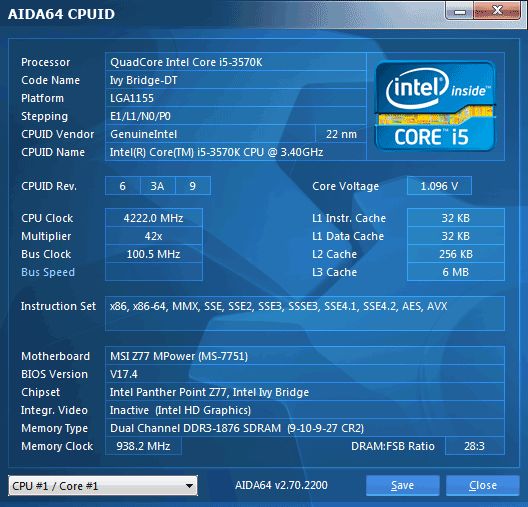
Everyone knows that no automatic overclocking system will produce the same exceptional and adequate results as manual overclocking, when each and every parameter is carefully selected. However, overclocking with Micro-Star mainboards may not be as versatile. The thing is that their voltage regulator circuitry doesn’t allow increasing the processor core voltage in Offset mode by adding the designed value to the nominal setting, and if the Vcore is set at a fixed value, then all power-saving technologies stop working. We have explained multiple times in our reviews why power-saving modes are important even for overclocked systems, and the most recent occasion when we dwelled on this topic in detail was in our Gigabyte GA-Z77X-UP7 mainboard review, therefore, we won’t repeat all of that here today. However, those processors, which are overclocked by raising their clock frequency multiplier, could be pushed to the limits with all Intel’s power-saving technologies and MSI’s proprietary APS technology intact even on MSI mainboards. All you have to do to accomplish that is to overclock without raising the core voltage. Therefore, it is impossible to overclock our specific test processor to its absolute maximum of 4.6 GHz. In our case, even 4.5 GHz became quite a challenge and only gave in when we set the Vdroop to the maximum. At the same time we set the memory frequency to 1867 MHz and adjusted its timings accordingly.
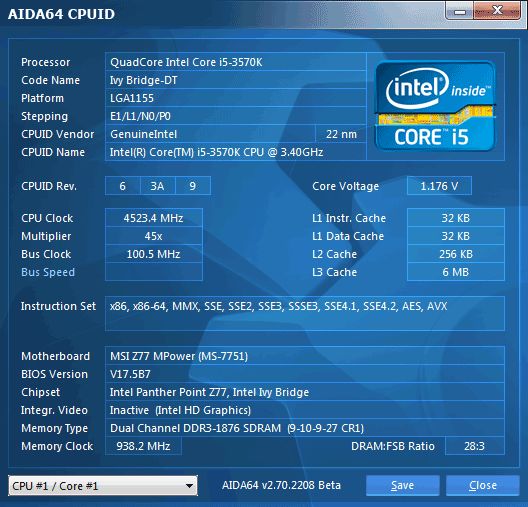
The system was overclocked in such a way that it could be used in this mode for a prolonged period of time. We did not disable any of the mainboard features or onboard controllers, kept all Intel processor power-saving technologies up and running normally, so that in idle mode the CPU voltage and frequency multiplier would get lowered, and all idling processor units would get disabled to bring the CPU into the energy-efficient mode. MSI’s proprietary APS power-saving technology was also up and running and adjusted the number of active phases in the processor voltage regulator circuitry dynamically depending on the workload level.
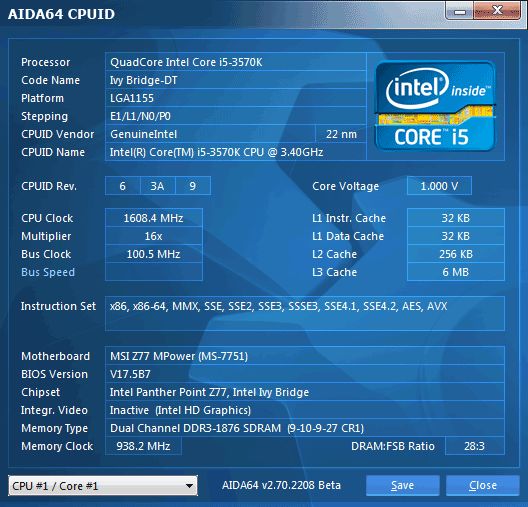
Performance Comparison
As usual, we are going to compare the mainboards speeds in two different modes: in nominal mode and during CPU and memory overclocking. The first mode is interesting because it shows how well the mainboards work with their default settings. It is a known fact that most users do not fine-tune their systems, they simply choose the optimal BIOS settings and do nothing else. That is why we run a round of tests almost without interfering in any way with the default mainboard settings. For comparison purposes we also included the results of the previously reviewed mainboards:
- ASRock Fatal1ty Z77 Professional
- ASRock Z77 Extreme4 and ASRock Z77 Extreme6
- ASRock Z77 Extreme9
- ASRock Z77 OC Formula
- Asus Maximus V Formula
- Asus P8Z77-V Deluxe
- Asus P8Z77-V LX
- Asus P8Z77-V Premium
- Asus Sabertooth Z77
- Gigabyte G1.Sniper 3
- Gigabyte GA-Z77X-UD3H and GA-Z77X-UD5H-WB WIFI
- Gigabyte GA-Z77X-UP4 TH and Gigabyte GA-Z77X-UP5 TH
- Gigabyte GA-Z77X-UP7
- Intel DZ77BH-55K
- Intel DZ77GA-70K and Intel DZ77RE-75K
- MSI Z77A-GD65.
The results on the diagrams are sorted out in descending order. The results of MSI Z77 MPOWER mainboard are highlighted with a darker color for your convenience.
Nominal Mode
We used Cinebench 11.5. All tests were run five times and the average result of the five runs was taken for the performance charts.
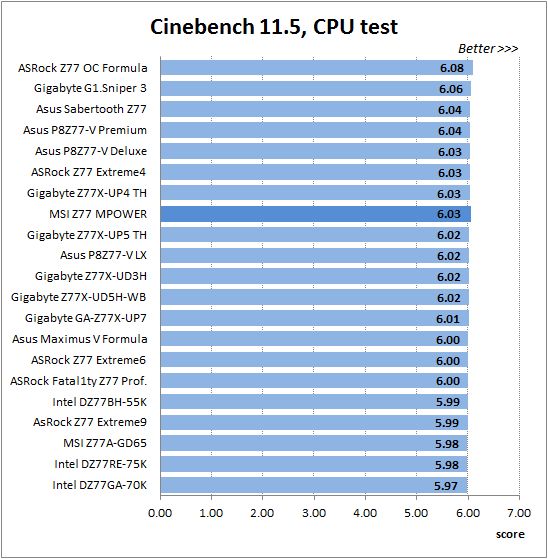
We have been using Fritz Chess Benchmark utility for a long time already and it proved very illustrative. It generated repeated results, the performance in it is scales perfectly depending on the number of involved computational threads.
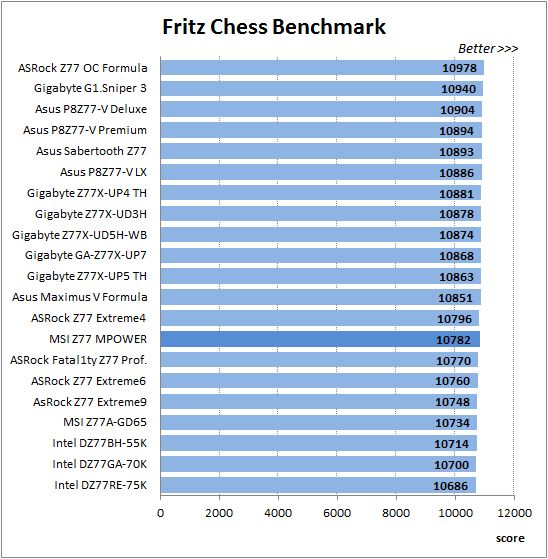
A small video in x264 HD Benchmark 4.0 is encoded in two passes and then the entire process is repeated four times. The average results of the second pass are displayed on the following diagram:
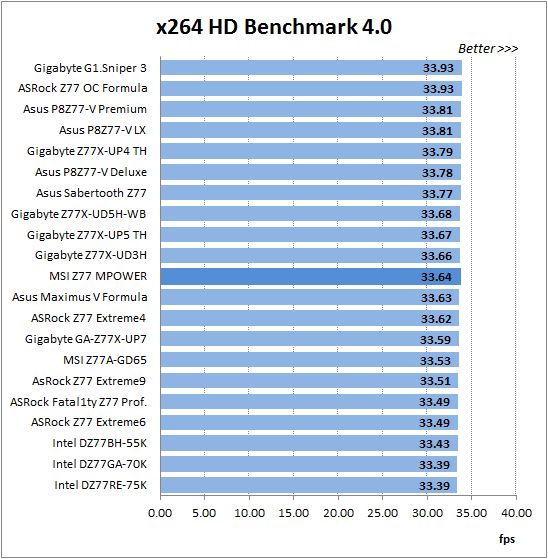
We measured the performance in Adobe Photoshop using our own benchmark made from Retouch Artists Photoshop Speed Test that has been creatively modified. It includes typical editing of four 10-megapixel images from a digital photo camera.
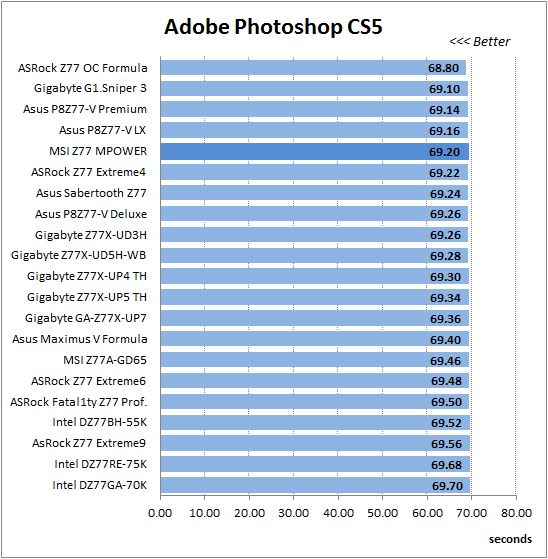
In the archiving test a 1 GB file is compressed using LZMA2 algorithms, while other compression settings remain at defaults.z
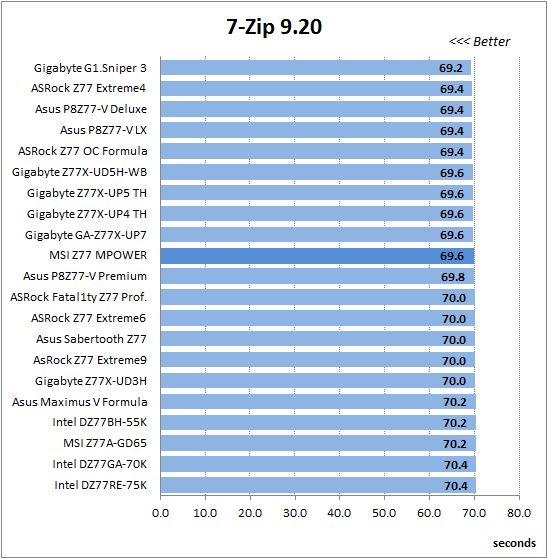
Like in the data compression test, the faster 16 million of Pi digits are calculated, the better. This is the only benchmark where the number of processor cores doesn’t really matter, because it creates single-threaded load.
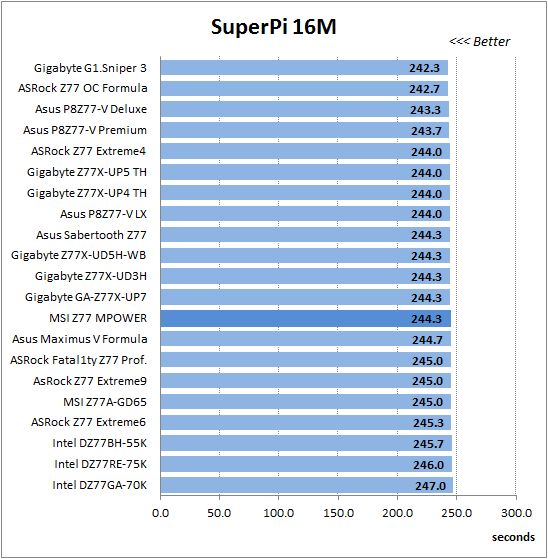
Since we do not overclock graphics in our mainboard reviews, the next diagram shows only CPU tests from the 3DMark11 – Physics Score. This score is obtained in a special physics test that emulates the behavior of a complex gaming system working with numerous objects:
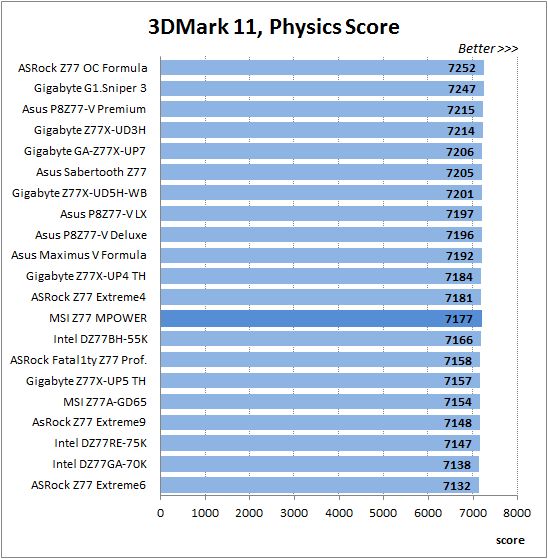
We use FC2 Benchmark Tool to go over Ranch Small map ten times in 1920×1080 resolution with high image quality settings in DirectX 10.
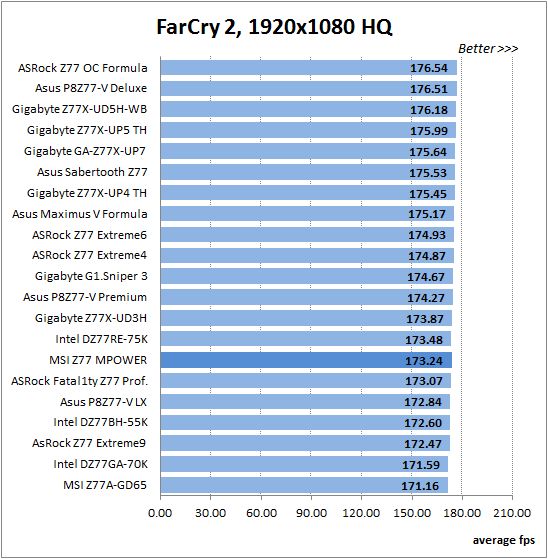
Resident Evil 5 game also has a built-in performance test. Its peculiarity is that it can really take advantage of multi-core processor architecture. The tests were run in DirectX 10 in 1920×1080 resolution with high image quality settings. The average of five test runs was taken for further analysis:
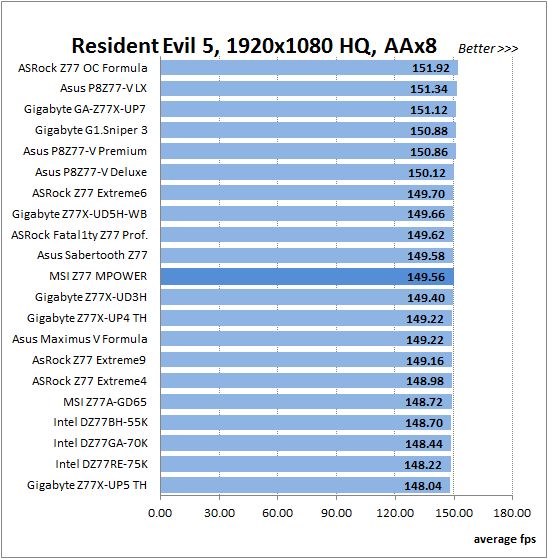
Batman: Arkham City game also reacts eagerly to any changes in the CPU clock frequency, but it uses DirectX 11. We ran game’s integrated benchmark five times with high image quality settings and then take the average of the five runs for the diagrams.
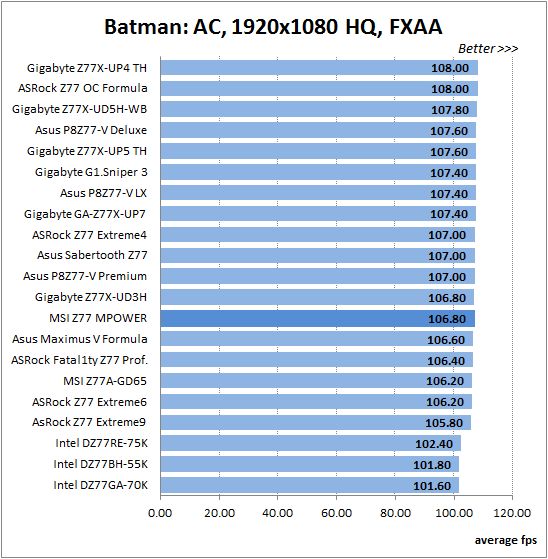
We see a great illustration of the known fact that related mainboards working in identical testing conditions demonstrate about the same performance. Therefore, it is not surprising that the performance of MSI Z77 MPOWER in the nominal mode is very similar to the performance of the other participants.
Overclocked Mode
During processor and memory overclocking, different mainboards accomplished different results, which we summed up in the following table for your convenience:
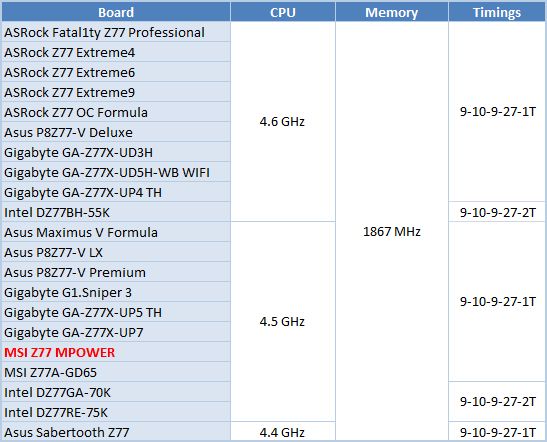
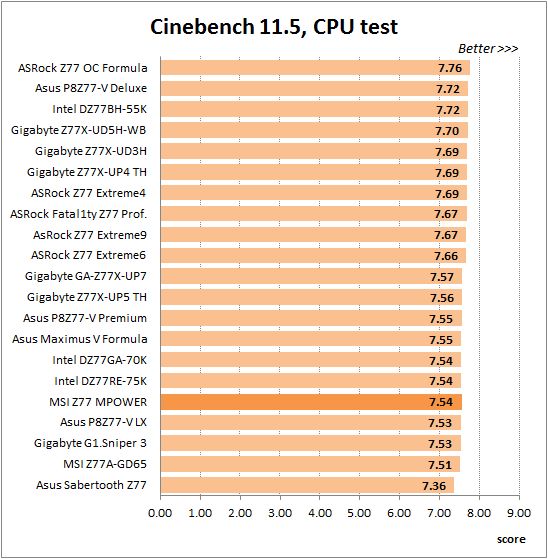
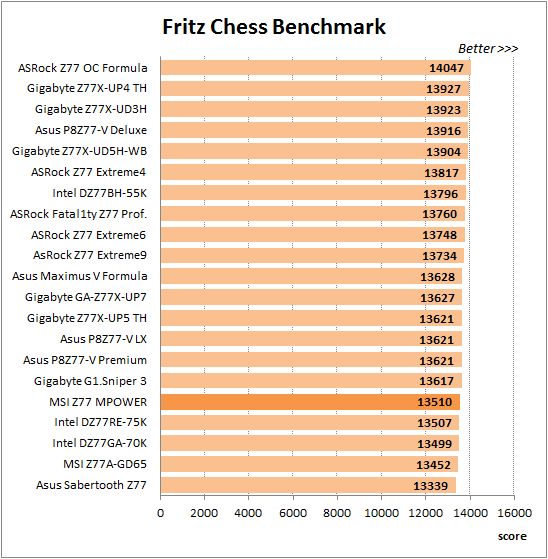
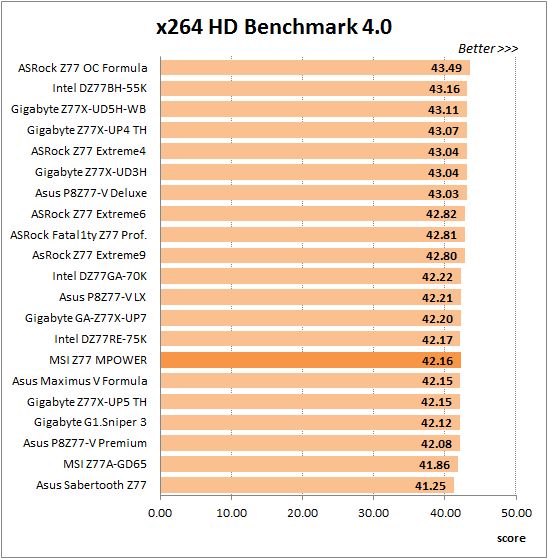
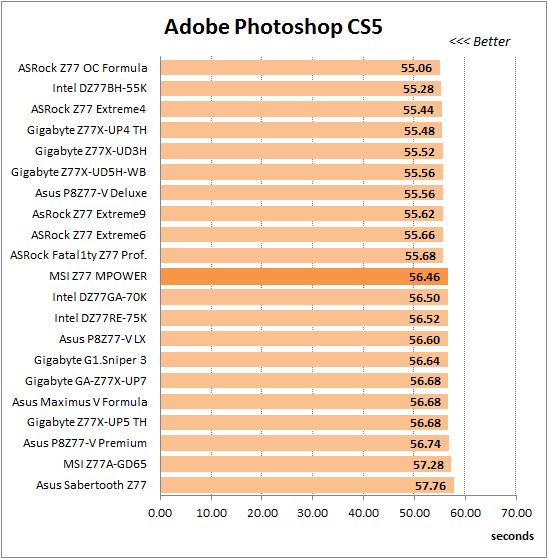
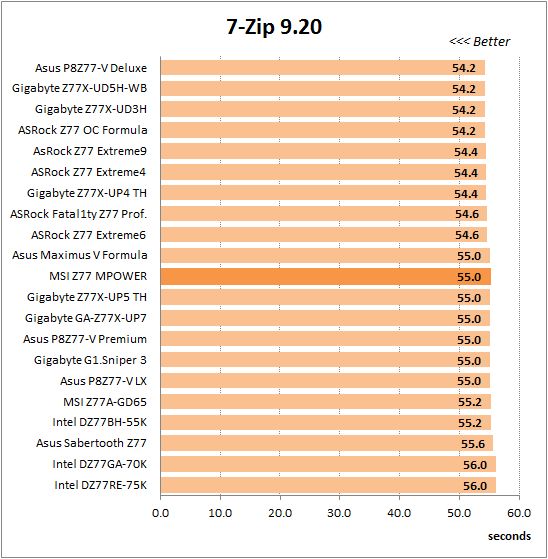
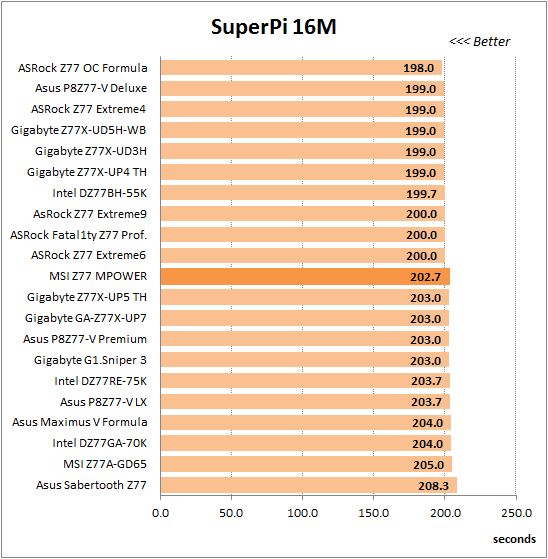
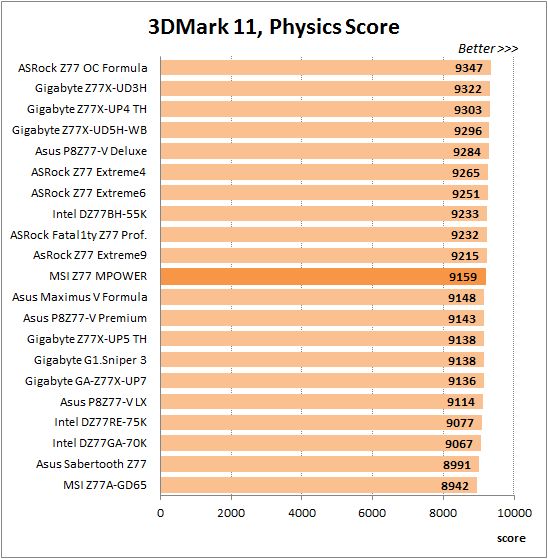
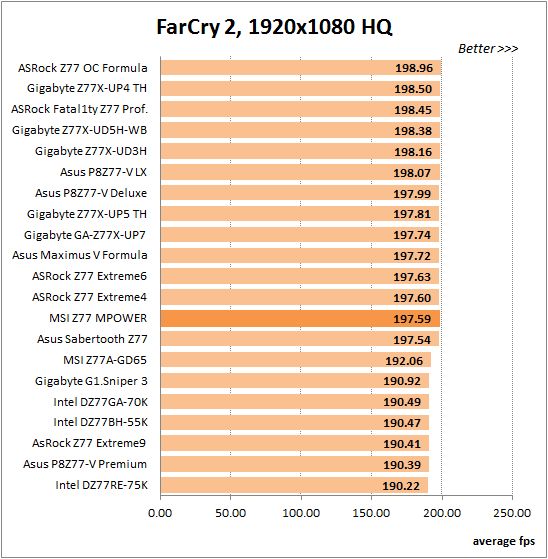
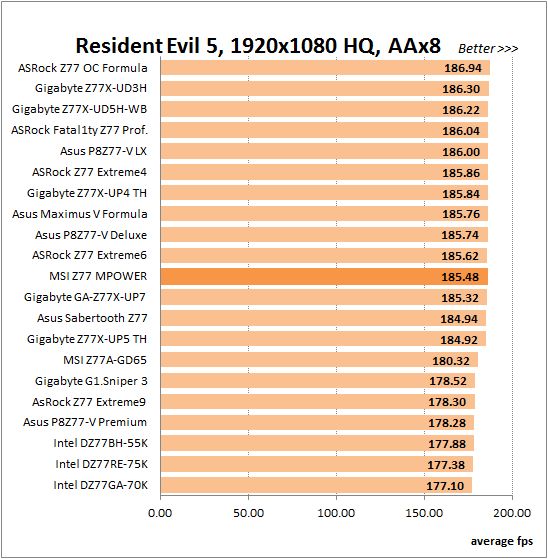
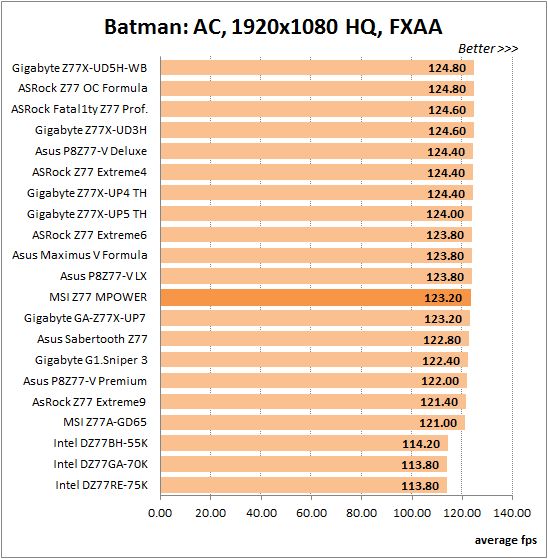
Since MSI Z77 MPOWER didn’t allow us to overclock our test CPU to its maximum frequency, it appears in the lower part of the diagrams for the most part. However, I would like to stress that in some cases it performed best of all other mainboards within the same overclocking interval, for example, in Adobe Photoshop CS5 and SuperPi tests. Moreover, it performed better than we had expected in the gaming tests. Of course, the difference between MSI Z77 MPOWER and other mainboard models is minimal, but at least it gives us every right to state with all certainty that MSI Z77 MPOWER has no performance issues, if you are using the proper BIOS version, of course.
Power Consumption
We performed our power consumption measurements using an Extech Power Analyzer 380803. This device is connected before the PSU and measures the power draw of the entire system (without the monitor), including the power loss that occurs in the PSU itself. In the idle mode we start the system up and wait until it stops accessing the hard disk. Then we use LinX to load the CPU. For a more illustrative picture there are graphs that show how the computer power consumption grows depending on the number of active execution threads in LinX (both at the default and overclocked system settings). The results of MSI Z77 MPOWER are marked with a darker color for your convenience.
Because of compatibility issues we uncovered in Gigabyte GA-Z77X-UP4 TH and Gigabyte GA-Z77X-UP5 TH mainboards with our original CoolerMaster RealPower M850 power supply unit, we had to replace it with Enermax NAXN ENM850EW. Both these PSUs have very similar technical characteristics, but Enermax NAXN ENM850EWT is about 1-3 W more energy-efficient than the Cooler Master unit. In order to be able to use the previously obtained results, we decided to make up for this efficiency difference by adding 2 W to all new power readings, so that we could still compare their results against the power consumption of all previously tested products.
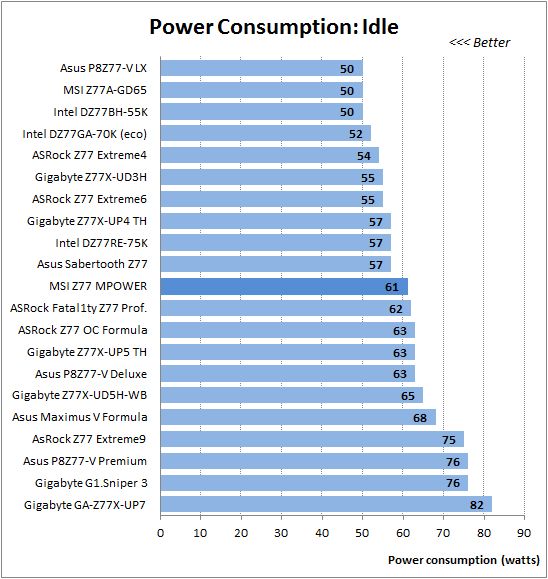
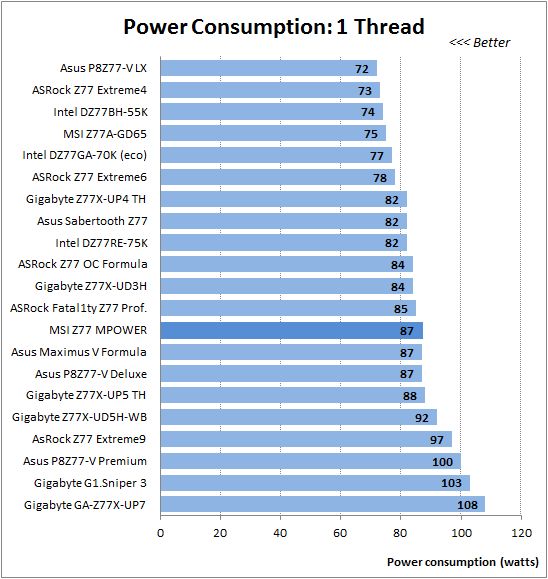
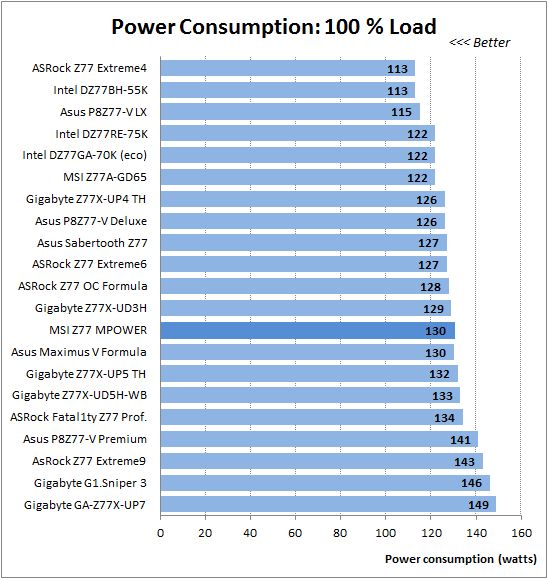
The diagrams show that MSI Z77 MPOWER mainboard demonstrates pretty average power consumption in the nominal mode. However, in reality this isn’t quite true, and the board is, actually, highly energy-efficient. Unfortunately, you can’t see this advantage with the default settings, because in this case the power-saving technologies are only partially operational and “Intel Turbo Boost” works incorrectly. However, as soon as you manually enable all available power-saving modes and return the CPU to its original nominal settings, the board transforms. At only 48 W MSI Z77 MPOWER could easily become the most energy-efficient mainboard in idle mode. Under heavy loads some competitors consume less, but it would still be among the leaders.
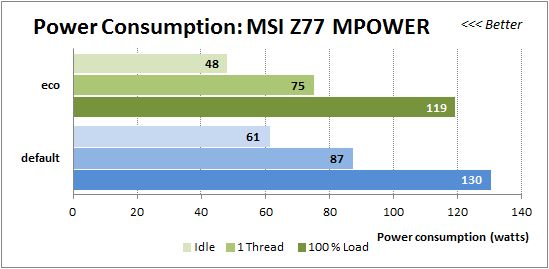
In overclocked mode the board looks great, showing lower power consumption than the majority of competitors, because all power-saving technologies remained intact. However, the positive effect from this achievement is overshadowed by the fact that we were unable to overclock our processor to the absolute maximum, since the board doesn’t allow raising the CPU Vcore in Offset mode and therefore we had to overclock without adjusting the CPU voltage.
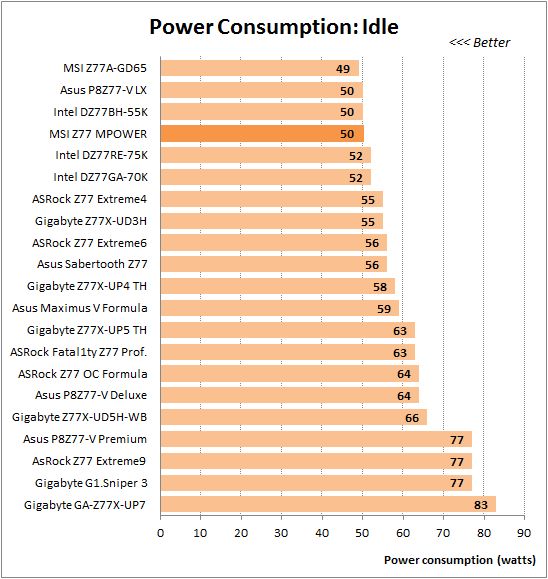
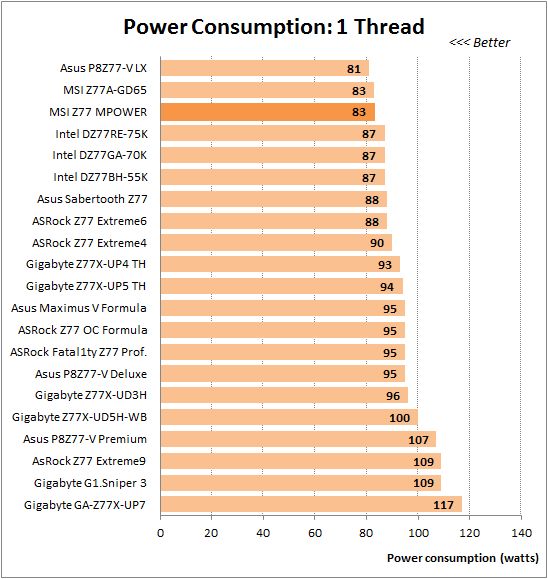
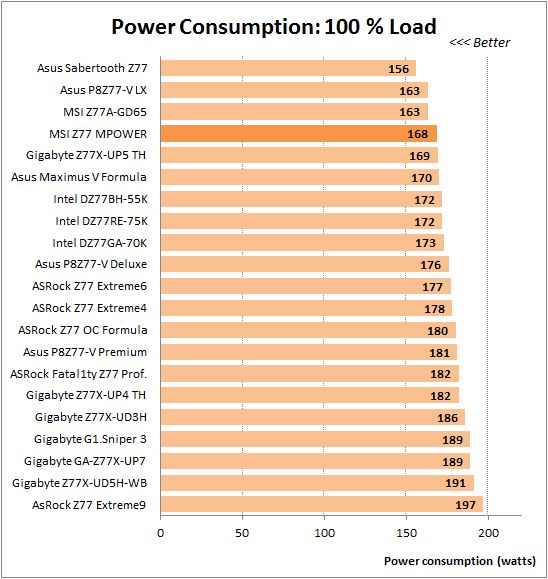
Conclusion
MSI Z77 MPOWER mainboard boasts numerous advantages. Some are typical of Micro-Star’s mainboards in general, such as high-quality electronic components, for example. Some belong to this specific mainboard model, such as Bluetooth and Wi-Fi support, for example. However, these advantages become secondary once you face multiple challenges this model has in stock for you. Yes, everything may happen: the model may turn out not so balanced, or we are plain unlucky with our specific sample. However, unfortunately, this is none of the above, because we have been pointing out the same exact things over and over again in our reviews.
You may see a slogan on the mainboard packaging and in the startup screen saying “Chang The Game Of Overclocking”. Yes, we understand what the idea was. The pre-sale quality check should have changed the standard situation when overclocking success is random and unpredictable. “OC Certified” seal should have guaranteed the board’s ability to overclock, but in reality nothing has changed. The mainboard still doesn’t support Vcore adjustment in Offset mode, which forces us to put up with lower overclocking results, in order to have an optimal and balanced overclocked system with all power-saving technologies up and running. The additional quality control step didn’t save us from any of the existing challenges with MSI mainboards.
In my opinion, the companies chose the wrong approach to improving their mainboards. Only Micro-Star knows how many MSI Z77 MPOWER mainboard fail the stress test, but I am certain that this number is minimal. In fact, we have never had any problems with the way they built their mainboards. On the contrary, MSI mainboards were often the ones where we would see new technologies, features and chips. We also have no complaints about the existing quality control system: all mainboards are always made very neatly and thoroughly. So, adding another quality control check before the mainboard is shipped off to the consumers may theoretically lower the already low number of defective units by a fraction of a percent, but hardly more than that. The root of the problem is completely different. The boards are of excellent quality, but they do not work well. Any impeccable mainboard is simply a well-balanced and organized cocktail of silicon, plastic and metal, and only software support from the BIOS can turn it into a quality product, which is exactly where MSI need to concentrate their efforts. Maybe what it takes is a new MSI Click BIOS III or maybe even IV, where they address all the reoccurring concerns and issues…